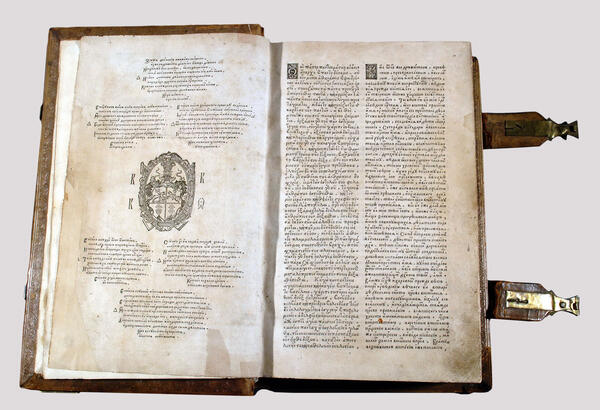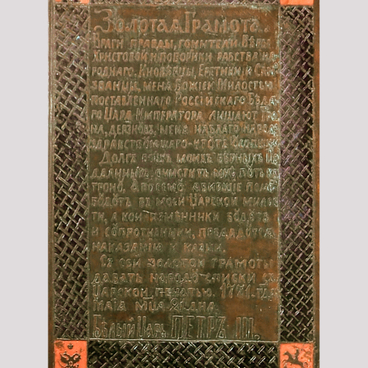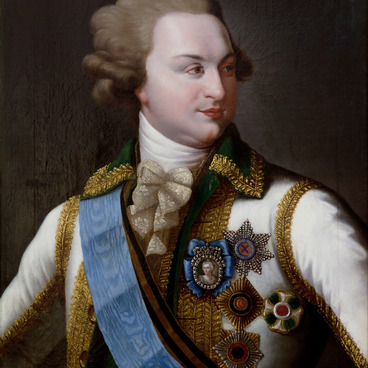Typography appeared in Russia in the middle of the 16th century. By that time, printed books were already known. They were in the library of the Grand Duke of Moscow. These were editions in Latin, Greek and other languages.
The Moscow Printing House, which was the first printing house in the Russian state, was opened under Tsar Ivan the Terrible in 1564. Ivan Fyodorov and Pyotr Mstislavets became the first Russian printers. The first precisely dated Russian book was ‘The Apostle’, published on March 1, 1564. However, the clergy came out against the printers. The enmity was due to the competition of scribal monks, whose labor prices were knocked down by the printed book. Ivan Fedorov had to leave his fatherland, and in 1568 he came to the Grand Duchy of Lithuania.
While abroad, the Russian educator did not stop his activity. One of the most influential nobles of the Grand Duchy of Lithuania, Prince Konstantin Konstantinovich Ostrogski, rendered significant help and support to Fedorov. Prince Ostrogski was the head of the Volyn land, the headman of Vladimir and the governor of Kiev. As a believer, in 1576 in the city of Ostrog he founded a school for the maintenance of Orthodoxy, and a year later — a printing house, headed by Ivan Fedorov.
In 1581, the printing house published the Ostrog Bible. The Ostrog Bible is the first complete edition of the Bible in Church Slavonic. Like all Fedorov’s publications, the Ostrog Bible is typed and impeccably typeset. A small, but readable “Ostrog” font is used for it, semiunical with elements of cursive styles. The volume of the text is 3 240 000 printed characters. Subsequently, the Ostrog Bible was reprinted without significant changes in Moscow in 1663, and, in fact, was the official edition of the Russian Bible until the 1740s. After that, the so-called Elisabeth Bible was compiled, which is used by the Russian Orthodox Church to this day.
The run of the first Russian printed Bible was 1,500 copies, which is colossal for those times. The Ostrog Bible is widely known in Ukraine, Russia and Belarus, as well as in other countries. It is also in the Oxford Library. There are currently less than 350 Ostrog Bibles preserved around the world.
The Moscow Printing House, which was the first printing house in the Russian state, was opened under Tsar Ivan the Terrible in 1564. Ivan Fyodorov and Pyotr Mstislavets became the first Russian printers. The first precisely dated Russian book was ‘The Apostle’, published on March 1, 1564. However, the clergy came out against the printers. The enmity was due to the competition of scribal monks, whose labor prices were knocked down by the printed book. Ivan Fedorov had to leave his fatherland, and in 1568 he came to the Grand Duchy of Lithuania.
While abroad, the Russian educator did not stop his activity. One of the most influential nobles of the Grand Duchy of Lithuania, Prince Konstantin Konstantinovich Ostrogski, rendered significant help and support to Fedorov. Prince Ostrogski was the head of the Volyn land, the headman of Vladimir and the governor of Kiev. As a believer, in 1576 in the city of Ostrog he founded a school for the maintenance of Orthodoxy, and a year later — a printing house, headed by Ivan Fedorov.
In 1581, the printing house published the Ostrog Bible. The Ostrog Bible is the first complete edition of the Bible in Church Slavonic. Like all Fedorov’s publications, the Ostrog Bible is typed and impeccably typeset. A small, but readable “Ostrog” font is used for it, semiunical with elements of cursive styles. The volume of the text is 3 240 000 printed characters. Subsequently, the Ostrog Bible was reprinted without significant changes in Moscow in 1663, and, in fact, was the official edition of the Russian Bible until the 1740s. After that, the so-called Elisabeth Bible was compiled, which is used by the Russian Orthodox Church to this day.
The run of the first Russian printed Bible was 1,500 copies, which is colossal for those times. The Ostrog Bible is widely known in Ukraine, Russia and Belarus, as well as in other countries. It is also in the Oxford Library. There are currently less than 350 Ostrog Bibles preserved around the world.



